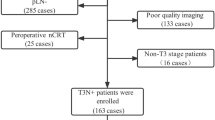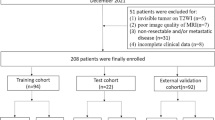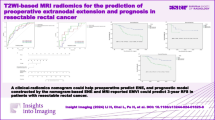Abstract
Purpose
To establish and validate an integrated model incorporating multiregional magnetic resonance imaging (MRI) radiomics features and clinical factors to predict tumor deposits (TDs) preoperatively in resectable rectal cancer (RC).
Methods
This study retrospectively included 148 resectable RC patients [TDs+ (n = 45); TDs− (n = 103)] from August 2016 to August 2022, who were divided randomly into a testing cohort (n = 45) and a training cohort (n = 103). Radiomics features were extracted from the volume of interest on T2-weighted images (T2WI) and diffusion-weighted images (DWI) from pretreatment MRI. Model construction was performed after feature selection. Finally, five classification models were developed by support vector machine (SVM) algorithm to predict TDs in resectable RC using the selected clinical factor, single-regional radiomics features (extracted from primary tumor), and multiregional radiomics features (extracted from the primary tumor and mesorectal fat). Receiver-operating characteristic (ROC) curve analysis was employed to assess the discrimination performance of the five models. The AUCs of five models were compared by DeLon’s test.
Results
The training and testing cohorts included 31 (30.1%) and 14 (31.1%) patients with TDs, respectively. The AUCs of multiregional radiomics, single-regional radiomics, and the clinical models for predicting TDs were 0.839, 0.765, and 0.793, respectively. An integrated model incorporating multiregional radiomics features and clinical factors showed good predictive performance for predicting TDs in resectable RC (AUC, 0.931; 95% CI, 0.841–0.988), which demonstrated superiority over clinical model (P = 0.016), the single-regional radiomics model (P = 0.042), and the multiregional radiomics model (P = 0.025).
Conclusion
An integrated model combining multiregional MRI radiomic features and clinical factors can improve prediction performance for TDs and guide clinicians in implementing treatment plans individually for resectable RC patients.
Graphical abstract








Similar content being viewed by others
References
Bray F, Ferlay J, Soerjomataram I, Siegel R L, Torre L A, Jemal A(2018) Global cancer statistics 2018: GLOBOCAN estimates of incidence and mortality worldwide for 36 cancers in 185 countries.CA Cancer J Clin 68 (6):394-424. https://doi.org/https://doi.org/10.3322/caac.21492
Keum N, Giovannucci E(2019) Global burden of colorectal cancer: emerging trends, risk factors and prevention strategies.Nat Rev Gastroenterol Hepatol 16 (12):713-732. https://doi.org/https://doi.org/10.1038/s41575-019-0189-8
Lin Q, Wei Y, Ren L, Zhong Y, Qin C, Zheng P, Xu P, Zhu D, Ji M, Xu J(2015) Tumor deposit is a poor prognostic indicator in patients who underwent simultaneous resection for synchronous colorectal liver metastases.Onco Targets Ther 8233-240. https://doi.org/https://doi.org/10.2147/ott.S71414
Lord A C, D’Souza N, Pucher P H, Moran B J, Abulafi A M, Wotherspoon A, Rasheed S, Brown G(2017) Significance of extranodal tumour deposits in colorectal cancer: A systematic review and meta-analysis.Eur J Cancer 8292-102. https://doi.org/https://doi.org/10.1016/j.ejca.2017.05.027
Ueno H, Hashiguchi Y, Shimazaki H, Shinto E, Kajiwara Y, Nakanishi K, Kato K, Maekawa K, Nakamura T, Yamamoto J, Hase K (2014) Peritumoral deposits as an adverse prognostic indicator of colorectal cancer.Am J Surg 207 (1):70-77. https://doi.org/https://doi.org/10.1016/j.amjsurg.2013.04.009
Diagnosis, Treatment Guidelines For Colorectal Cancer Working Group C(2019) Chinese Society of Clinical Oncology (CSCO) diagnosis and treatment guidelines for colorectal cancer 2018 (English version).Chin J Cancer Res 31 (1):117-134. https://doi.org/https://doi.org/10.21147/j.issn.1000-9604.2019.01.07
Glynne-Jones R, Wyrwicz L, Tiret E, Brown G, Rödel C, Cervantes A, Arnold D(2018) Rectal cancer: ESMO Clinical Practice Guidelines for diagnosis, treatment and follow-up.Ann Oncol 29 (Suppl 4):iv263. https://doi.org/https://doi.org/10.1093/annonc/mdy161
Hashiguchi Y, Muro K, Saito Y, Ito Y, Ajioka Y, Hamaguchi T, Hasegawa K, Hotta K, Ishida H, Ishiguro M, Ishihara S, Kanemitsu Y, Kinugasa Y, Murofushi K, Nakajima T E, Oka S, Tanaka T, Taniguchi H, Tsuji A, Uehara K, Ueno H, Yamanaka T, Yamazaki K, Yoshida M, Yoshino T, Itabashi M, Sakamaki K, Sano K, Shimada Y, Tanaka S, Uetake H, Yamaguchi S, Yamaguchi N, Kobayashi H, Matsuda K, Kotake K, Sugihara K(2020) Japanese Society for Cancer of the Colon and Rectum (JSCCR) guidelines 2019 for the treatment of colorectal cancer.Int J Clin Oncol 25 (1):1-42. https://doi.org/https://doi.org/10.1007/s10147-019-01485-z
Jin M, Frankel W L (2018) Lymph Node Metastasis in Colorectal Cancer.Surg Oncol Clin N Am 27 (2):401-412. https://doi.org/https://doi.org/10.1016/j.soc.2017.11.011
Pricolo V E, Steingrimsson J, McDuffie T J, McHale J M, McMillen B, Shparber M(2020) Tumor Deposits in Stage III Colon Cancer: Correlation With Other Histopathologic Variables, Prognostic Value, and Risk Stratification-Time to Consider “N2c”.Am J Clin Oncol 43 (2):133-138. https://doi.org/https://doi.org/10.1097/coc.0000000000000645
Washington M K, Berlin J, Branton P, Burgart L J, Carter D K, Fitzgibbons P L, Halling K, Frankel W, Jessup J, Kakar S, Minsky B, Nakhleh R, Compton C C(2009) Protocol for the examination of specimens from patients with primary carcinoma of the colon and rectum.Arch Pathol Lab Med 133 (10):1539-1551. https://doi.org/https://doi.org/10.5858/133.10.1539
Nagtegaal I D, Knijn N, Hugen N, Marshall H C, Sugihara K, Tot T, Ueno H, Quirke P(2017) Tumor Deposits in Colorectal Cancer: Improving the Value of Modern Staging-A Systematic Review and Meta-Analysis.J Clin Oncol 35 (10):1119-1127. https://doi.org/https://doi.org/10.1200/jco.2016.68.9091
Bouquot M, Creavin B, Goasguen N, Chafai N, Tiret E, André T, Flejou J F, Parc Y, Lefevre J H, Svrcek M(2018) Prognostic value and characteristics of N1c colorectal cancer.Colorectal Dis 20 (9):O248-o255. https://doi.org/https://doi.org/10.1111/codi.14289
Yagi R, Shimada Y, Kameyama H, Tajima Y, Okamura T, Sakata J, Kobayashi T, Kosugi S I, Wakai T, Nogami H, Maruyama S, Takii Y, Kawasaki T, Honma K I (2016) Clinical Significance of Extramural Tumor Deposits in the Lateral Pelvic Lymph Node Area in Low Rectal Cancer: A Retrospective Study at Two Institutions.Ann Surg Oncol 23 (Suppl 4):552-558. https://doi.org/https://doi.org/10.1245/s10434-016-5379-9
Weiser M R (2018) AJCC 8th Edition: Colorectal Cancer.Ann Surg Oncol 25 (6):1454-1455. https://doi.org/https://doi.org/10.1245/s10434-018-6462-1
Glynne-Jones R, Wyrwicz L, Tiret E, Brown G, Rödel C, Cervantes A, Arnold D(2017) Rectal cancer: ESMO Clinical Practice Guidelines for diagnosis, treatment and follow-up.Ann Oncol 28 (suppl_4):iv22-iv40. https://doi.org/https://doi.org/10.1093/annonc/mdx224
Nougaret S, Jhaveri K, Kassam Z, Lall C, Kim D H(2019) Rectal cancer MR staging: pearls and pitfalls at baseline examination.Abdom Radiol (NY) 44 (11):3536-3548. https://doi.org/https://doi.org/10.1007/s00261-019-02024-0
Fernandes M C, Gollub M J, Brown G(2022) The importance of MRI for rectal cancer evaluation.Surg Oncol 43101739. https://doi.org/https://doi.org/10.1016/j.suronc.2022.101739
Hoshino N, Murakami K, Hida K, Sakamoto T, Sakai Y(2019) Diagnostic accuracy of magnetic resonance imaging and computed tomography for lateral lymph node metastasis in rectal cancer: a systematic review and meta-analysis.Int J Clin Oncol 24 (1):46-52. https://doi.org/https://doi.org/10.1007/s10147-018-1349-5
Li X T, Sun Y S, Tang L, Cao K, Zhang X Y(2015) Evaluating local lymph node metastasis with magnetic resonance imaging, endoluminal ultrasound and computed tomography in rectal cancer: a meta-analysis.Colorectal Dis 17 (6):O129-135. https://doi.org/https://doi.org/10.1111/codi.12909
Lambin P, Rios-Velazquez E, Leijenaar R, Carvalho S, van Stiphout R G, Granton P, Zegers C M, Gillies R, Boellard R, Dekker A, Aerts H J(2012) Radiomics: extracting more information from medical images using advanced feature analysis.Eur J Cancer 48 (4):441-446. https://doi.org/https://doi.org/10.1016/j.ejca.2011.11.036
Antunes J T, Ofshteyn A, Bera K, Wang E Y, Brady J T, Willis J E, Friedman K A, Marderstein E L, Kalady M F, Stein S L, Purysko A S, Paspulati R, Gollamudi J, Madabhushi A, Viswanath S E(2020) Radiomic Features of Primary Rectal Cancers on Baseline T (2) -Weighted MRI Are Associated With Pathologic Complete Response to Neoadjuvant Chemoradiation: A Multisite Study.J Magn Reson Imaging 52 (5):1531-1541. https://doi.org/https://doi.org/10.1002/jmri.27140
Bi W L, Hosny A, Schabath M B, Giger M L, Birkbak N J, Mehrtash A, Allison T, Arnaout O, Abbosh C, Dunn I F, Mak R H, Tamimi R M, Tempany C M, Swanton C, Hoffmann U, Schwartz L H, Gillies R J, Huang R Y, Aerts H(2019) Artificial intelligence in cancer imaging: Clinical challenges and applications.CA Cancer J Clin 69 (2):127-157. https://doi.org/https://doi.org/10.3322/caac.21552
Gillies R J, Kinahan P E, Hricak H (2016) Radiomics: Images Are More than Pictures, They Are Data.Radiology 278 (2):563-577. https://doi.org/https://doi.org/10.1148/radiol.2015151169
Atre I D, Eurboonyanun K, Noda Y, Parakh A, O’Shea A, Lahoud R M, Sell N M, Kunitake H, Harisinghani M G(2021) Utility of texture analysis on T2-weighted MR for differentiating tumor deposits from mesorectal nodes in rectal cancer patients, in a retrospective cohort.Abdom Radiol (NY) 46 (2):459-468. https://doi.org/https://doi.org/10.1007/s00261-020-02653-w
Chen L D, Li W, Xian M F, Zheng X, Lin Y, Liu B X, Lin M X, Li X, Zheng Y L, Xie X Y, Lu M D, Kuang M, Xu J B, Wang W(2020) Preoperative prediction of tumour deposits in rectal cancer by an artificial neural network-based US radiomics model.Eur Radiol 30 (4):1969-1979. https://doi.org/https://doi.org/10.1007/s00330-019-06558-1
Jin Y, Li M, Zhao Y, Huang C, Liu S, Liu S, Wu M, Song B(2021) Computed Tomography-Based Radiomics for Preoperative Prediction of Tumor Deposits in Rectal Cancer.Front Oncol 11710248. https://doi.org/https://doi.org/10.3389/fonc.2021.710248
Yang Y S, Feng F, Qiu Y J, Zheng G H, Ge Y Q, Wang Y T(2021) High-resolution MRI-based radiomics analysis to predict lymph node metastasis and tumor deposits respectively in rectal cancer.Abdom Radiol (NY) 46 (3):873-884. https://doi.org/https://doi.org/10.1007/s00261-020-02733-x
Jayaprakasam V S, Paroder V, Gibbs P, Bajwa R, Gangai N, Sosa R E, Petkovska I, Golia Pernicka J S, Fuqua J L, 3rd, Bates D D B, Weiser M R, Cercek A, Gollub M J(2022) MRI radiomics features of mesorectal fat can predict response to neoadjuvant chemoradiation therapy and tumor recurrence in patients with locally advanced rectal cancer.Eur Radiol 32 (2):971-980. https://doi.org/https://doi.org/10.1007/s00330-021-08144-w
Liu X, Yang Q, Zhang C, Sun J, He K, Xie Y, Zhang Y, Fu Y, Zhang H(2020) Multiregional-Based Magnetic Resonance Imaging Radiomics Combined With Clinical Data Improves Efficacy in Predicting Lymph Node Metastasis of Rectal Cancer.Front Oncol 10585767. https://doi.org/https://doi.org/10.3389/fonc.2020.585767
Shaish H, Aukerman A, Vanguri R, Spinelli A, Armenta P, Jambawalikar S, Makkar J, Bentley-Hibbert S, Del Portillo A, Kiran R, Monti L, Bonifacio C, Kirienko M, Gardner K L, Schwartz L, Keller D(2020) Radiomics of MRI for pretreatment prediction of pathologic complete response, tumor regression grade, and neoadjuvant rectal score in patients with locally advanced rectal cancer undergoing neoadjuvant chemoradiation: an international multicenter study.Eur Radiol 30 (11):6263-6273. https://doi.org/https://doi.org/10.1007/s00330-020-06968-6
Pan A F, Zheng N X, Wang J, Kabemba J L T, Zheng K, Shen F, Zhang W, Gao X H(2022) Role of Perirectal Fat in the Carcinogenesis and Development of Early-Onset Rectal Cancer.J Oncol 20224061142. https://doi.org/https://doi.org/10.1155/2022/4061142
Song Y, Zhang J, Zhang Y D, Hou Y, Yan X, Wang Y, Zhou M, Yao Y F, Yang G(2020) FeAture Explorer (FAE): A tool for developing and comparing radiomics models.PLoS One 15 (8):e0237587. https://doi.org/https://doi.org/10.1371/journal.pone.0237587
van Griethuysen J J M, Fedorov A, Parmar C, Hosny A, Aucoin N, Narayan V, Beets-Tan R G H, Fillion-Robin J C, Pieper S, Aerts H (2017) Computational Radiomics System to Decode the Radiographic Phenotype.Cancer Res 77 (21):e104-e107. https://doi.org/https://doi.org/10.1158/0008-5472.Can-17-0339
Gopal P, Lu P, Ayers G D, Herline A J, Washington M K(2014) Tumor deposits in rectal adenocarcinoma after neoadjuvant chemoradiation are associated with poor prognosis.Mod Pathol 27 (9):1281-1287. https://doi.org/https://doi.org/10.1038/modpathol.2013.239
Ng F, Kozarski R, Ganeshan B, Goh V(2013) Assessment of tumor heterogeneity by CT texture analysis: can the largest cross-sectional area be used as an alternative to whole tumor analysis?Eur J Radiol 82 (2):342-348. https://doi.org/https://doi.org/10.1016/j.ejrad.2012.10.023
Braman N M, Etesami M, Prasanna P, Dubchuk C, Gilmore H, Tiwari P, Plecha D, Madabhushi A(2017) Intratumoral and peritumoral radiomics for the pretreatment prediction of pathological complete response to neoadjuvant chemotherapy based on breast DCE-MRI.Breast Cancer Res 19 (1):57. https://doi.org/https://doi.org/10.1186/s13058-017-0846-1
Kickingereder P, Bonekamp D, Nowosielski M, Kratz A, Sill M, Burth S, Wick A, Eidel O, Schlemmer H P, Radbruch A, Debus J, Herold-Mende C, Unterberg A, Jones D, Pfister S, Wick W, von Deimling A, Bendszus M, Capper D (2016) Radiogenomics of Glioblastoma: Machine Learning-based Classification of Molecular Characteristics by Using Multiparametric and Multiregional MR Imaging Features.Radiology 281 (3):907-918. https://doi.org/https://doi.org/10.1148/radiol.2016161382
Li Z C, Bai H, Sun Q, Li Q, Liu L, Zou Y, Chen Y, Liang C, Zheng H(2018) Multiregional radiomics features from multiparametric MRI for prediction of MGMT methylation status in glioblastoma multiforme: A multicentre study.Eur Radiol 28 (9):3640-3650. https://doi.org/https://doi.org/10.1007/s00330-017-5302-1
Acknowledgments
We thank Jibo Jia (Department of Radiology, the Third People’s Hospital of Kunshan, No. 615 Zizhu road, Kunshan, Jiangsu Province 215003, China) for providing some suggestions on the data processing software used in our research.
Funding
This work was supported by Gusu health talent project of Suzhou (GSWS2020003)
Author information
Authors and Affiliations
Contributions
FWF and CHH participated in the conception/ design. YQL and JYB participated in the provision of study material or patients. JYB and RH participated in the collection and/or assembly of data. FWF and YQL participated in the data analysis and interpretation. FWF participated in the manuscript writing. SH and CHH participated in the manuscript revision. All authors contributed to final approval of manuscript.
Corresponding authors
Ethics declarations
Conflict of interest
All authors declare that there is no conflict of interest.
Ethical approval
This study was in accordance with the current ethical standards of the institutional and national research committee and with the 1964 Helsinki Declaration and its later amendments or comparable ethical standards.
Additional information
Publisher's Note
Springer Nature remains neutral with regard to jurisdictional claims in published maps and institutional affiliations.
Supplementary Information
Below is the link to the electronic supplementary material.
Rights and permissions
Springer Nature or its licensor (e.g. a society or other partner) holds exclusive rights to this article under a publishing agreement with the author(s) or other rightsholder(s); author self-archiving of the accepted manuscript version of this article is solely governed by the terms of such publishing agreement and applicable law.
About this article
Cite this article
Feng, F., Liu, Y., Bao, J. et al. Multiregional-based magnetic resonance imaging radiomics model for predicting tumor deposits in resectable rectal cancer. Abdom Radiol 48, 3310–3321 (2023). https://doi.org/10.1007/s00261-023-04013-w
Received:
Revised:
Accepted:
Published:
Issue Date:
DOI: https://doi.org/10.1007/s00261-023-04013-w




